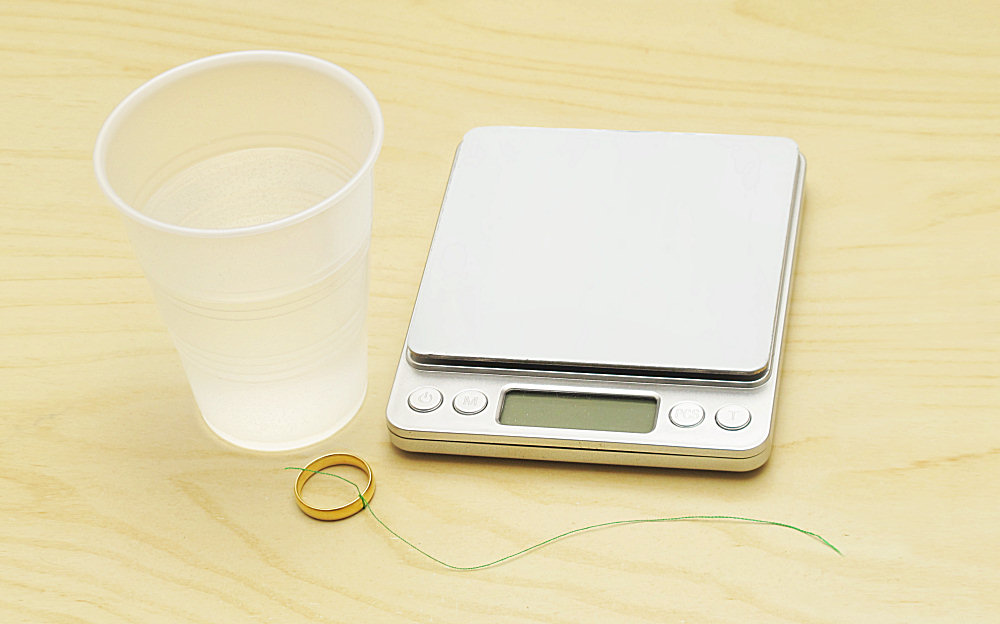In our last blog post we warned about scammers that sell deceptively real looking fake jewelry. The jewelry had “18 KT” hallmarks and the gold plating was applied to brass as a non-magnetic base material so it would pass a simple test with a magnet.
In this blog post we will show you how to identify even these non-magnetic fake jewelry pieces with simple means. All you need is a cup of water, a string and a precise kitchen scale.
If you’re curious to learn how the whole process works then keep reading. In the following 2 examples we will determine the density of a real 14 kt gold ring and a fake “14 kt” gold plated watch case cover.
Example 1: Ring 14 kt (real)
- Step1

Weigh the jewelry piece and note down the item weight (in g)
- Step2

Tie a thin string (yarn, fishing line, etc.) to the item. The thinner the string, the more accurate your results will be.
- Step3

Fill a light plastic cup with water at room temperature (about 20 – 25°C). Then place the cup on the scale and tare it (set scale to zero).
- Step4


Now we determine how much water is displaced by the item we want to test. Since water at room temperature has a density of roughly 1 g/cm³, the weight of the displaced water is equivalent to the volume of the item. That may sound complicated but it’s not rocket science. Just follow the instructions below.
Immerse the item in the water in the cup, holding it by the string. Make sure the item is fully immersed (below the water surface), but doesn’t touch the walls/bottom of the cup (that is very important). Also, make sure it doesn’t have any air bubbles stuck to it. Air bubbles can be removed by jiggling the item a little bit with the string. Note down the weight the scale shows with the item immersed from the string. This is the weight of the displaced water which is equivalent to the volume of the item as explained above. Note this number down as the item volume (in cm³). - Step5
With the following formula we can now easily calculate the density of the item.
density = item weight (g) = 5.09 g ≈ 14.1 g item volume (cm³) 0.36 cm³ cm³
Example 2: Watch case lid 14 kt gold plated (fake)
- Step1

Weigh the item, note down the weight (in g)
- Step2

Immerse the item in the water in the cup, note down the displaced water weight which is equivalent to the volume of the item (in cm³).
- Step3
Now we again calculate the density of the item.
density = item weight (g) = 7.70 g ≈ 8.7 g item volume (cm³) 0.89 cm³ cm³
Now that we have determined the densities of our items we can compare them with known values provided in the list below:
Densities of various materials*:
| Material | Density g/cm³ |
|---|---|
| 99.99% platinum | 21.4 |
| 24 kt gold | 19.3 |
| 99% tungsten | 19.3 |
| 18 kt gold | 14.7 – 16.9 |
| 14 kt gold | 12.9 – 14.6 |
| 10 kt gold | 10.9 – 12.8 |
| lead | 11.4 |
| 99.9% silver | 10.5 |
| sterling silver | 10.2 |
| copper | 8.9 |
| brass | 8.2 – 8.8 |
| stainless steel | 7.7-8.0 |
| iron | 7.9 |
We calculated the density of the real 14 kt gold ring to be 14.1 g/cm³ which falls right into the range where it should be for a 14 kt gold alloy.
The fake 14 kt watch case on the other hand came out to have a density 8.7 g/cm³ which falls right into the range for brass. Therefore we know this can only be a plated item and it is not real “solid” 14 kt gold.
IMPORTANT – How to avoid possible sources of error
Make sure the item is not hollow:
If the item is hollow on the inside, the air bubble on the inside will increase the volume of the item when immersing the item in water and your density result will be too low (so it might look like a “fake” even when it is actually a real piece). If this is the case (and you want to sell the item as scrap anyways), you can take a pair of pliers and squeeze the item into a flat piece that is no longer hollow prior to immersing it in water. That way you can get an accurate volume for the item and a correct density.
Make sure the item has no more stones attached:
Any stones or other decorative/functional (clasp etc.) elements on the item will have a significantly lower density than the precious metals, so they have to be removed prior to weighing / immersion in order to get a correct result.
Make sure the item doesn’t touch the walls or the bottom of the cup when immersing the item in water:
If the item touches the walls or the bottom of the cup while determining the volume, this will cause a very large error and has to be avoided in order to achieve an accurate volume reading.
Make sure that there are no air bubbles on or inside of the item when it is immersed in water:
Air bubbles that form on the item when you immerse it in water and stay attached. will add to the volume of the item and therefore give you a higher volume for the item and therefore the density will be too low. To get an accurate result you will have to jiggle the item around a little bit until all air bubbles are gone.






